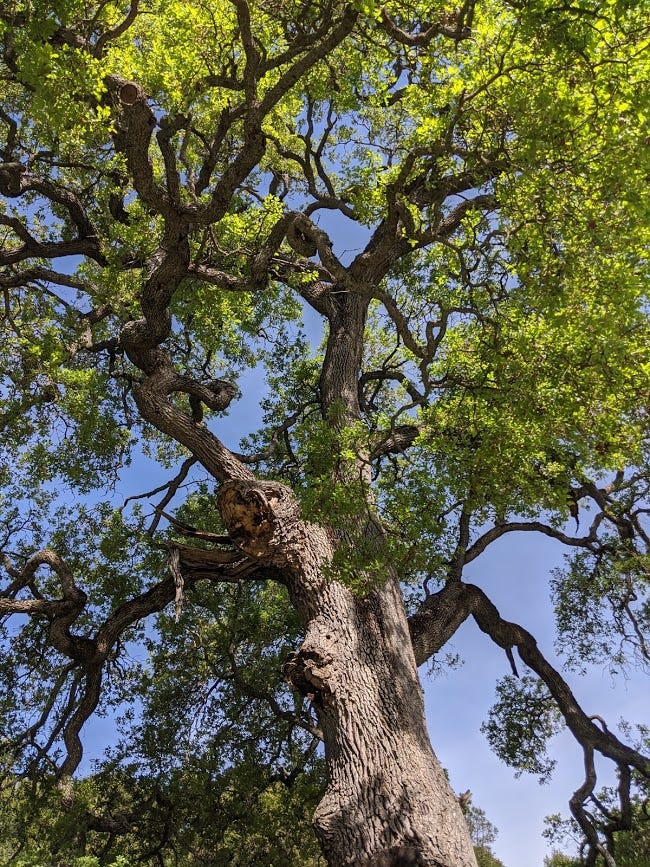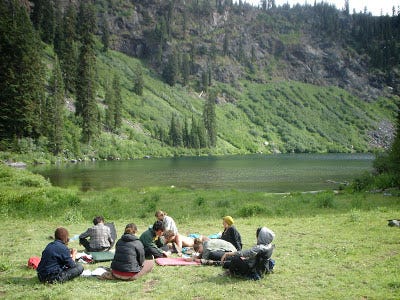The radical act of touching the ground
There is nothing romantic or fanciful about staying connected with the Earth.
It may seem like a strange moment to talk about connecting with the Earth, the ground, the life under our feet and around us. We are witnessing an unfolding of acts and behaviors that are flagrantly in violation of a systemic, holistic, reverent and sacred relationship with the miracle of our lives. This experience is beyond maps and blueprints—although humans have certainly cycled through numerous times of brutality, violence, and domination.
The difference this time, is we know too much.
The cat is out of the bag; the collective consciousness is such that we have the capacity to know what could be different. What is possible. We are literally straddling worlds between what is, what is becoming, and what may be.
How do we hold this? To respond? To dream and stitch together our lives?
Are we now ready to move, as a colleague put it, “from performative to meaning”?
Zizek, the famously provocative philosopher called this, “In excess of the Real.” When what is unfolding may exceed our capacities to cognitively process. We are served to explore beyond the usual modalities of conceptual analysis and ‘figuring it out' and turn towards additional sources of wisdom, resourcing and intelligence. This is a good time to touch the Earth, to ground, to return to what is felt, sensed and known. Outside of our usual cognitive processing.
I believe we have access to the tools and resources to enable us to not only navigate this time, but to turn the ship around.
I call this “Guiding” as short-hand for an entire way of being and relating to our world, from a position of relationship, relationality, attunement, and presence. All big lofty terms, that come down to some simple practices. That we can learn.
It starts with the recognition that our minds (as in “brain”) on their own, will not solve or figure this out. It is a sort of humbling; and also a sort of unlearning and letting go of our defaults.
Guiding is also about a way of being—leading, truly—that practices self-awareness, and mindfulness of our impacts on others.
It is about cultivating the conditions for change. Which is about relationship, grounding and presence.
I learned this directly during a life-changing experience: a 2-month field study, living in different California wilderness regions when I was 20. A small cohort of us packed out books, notebooks, supplies and provisions, and with brief re-supplies in the “front country,” lived in the back country. We followed a methodology created by Robert Greenway, the wilderness psychologist (yes, there is such a thing) who saw time in nature as ‘crossing a boundary.’ (He writes about this in the brilliant essay, Crossing the Wilderness Boundary, an under-recognized contribution to what we call ecopsychology and climate psychology today, published in 1995 in the seminal Ecopsychology.) We were encouraged to stay present and focused on our surroundings, avoid chit-chat, and essentially stay in relationship with the Earth as much as possible. This was less about being naturalists naming species, and more about immersion in the experience of simply letting nature be the teacher, as our teacher (consummate Guide) Walker Abel liked to say.
In addition to this the physicality of living outdoors for 2 months, we were immersing ourselves in deep ecology, ecofeminism, radical critical psychology, systems thinking, indigenous teachings, shamanic practices, transcendentalists, environmental justice, transpersonal psychology, Buddhist teachings, poetry, and nature writing. We also unveiled the tropes, narratives and stories we had been fed as young North Americans, pulling back the curtain to reveal a confrontation with generations of transgressions and colonization. It was a lot to process—and we had our group and the Earth to contain and support us.
It was this immersion experience that taught me that no matter what, we are in relationship and conversation with nature, our biotic ecosystems, the Earth itself: and it is a fine time to turn our attention there.
Now we collectively have a lot to process. What resources can we turn to, and offer?
Connecting with the Earth, the ground, the life around us, is baseline. There is no transformation without being in relationship and dialogue with life.

So I want to offer today a few guiding notes. Not a prescription, or a “how-to” per se. Instead see this as a “code” if you will, a playbook you can explore and test out. That may support your growth and evolution as a Guide.
Which the world needs, now.
Here are the Guiding Principles generated via Project InsideOut—also the mainstay of the resources, trainings and programs I am commissioned to create. Mostly this work has been for organizations. It’s very powerful and impactful when working with teams and leaders. I feel it’s time to offer this more widely. (If interested drop me a line.)

1. Attune.
This principle is truly about relationship. This includes attuning with your own environment, the land and ground, the life around you. Whether you are in an urban space or out the backcountry; there is life around you. This is a good time to attune to non-human life. To get very quiet. take time to do what Jon Young calls the “Sit Spot,” a practice I incorporate even in corporate settings. (This ties to the nature connection movement, something I review in the Quadrants framework, and I will share more on soon.) Attune to your own experience. Take time to connect with yourself and your experience with curiosity and non-judgement. Seek out resources to help you.
2. Reveal.
Tell the truth and share what is up for you, with attunement and compassion for those you are engaging with. Family, friends, your clients, your stakeholders, your board, millions of people who follow you. It does not matter. When you tell the truth, remember the neuroscience of how activation impacts our cognitive functioning. These principles are designed to help you navigate this. A big part of Reveal is simple: name what is hard and overwhelming. Acknowledge what may be coming up for others. “I know, this is a lot, it’s overwhelming and….. are you open to hearing what I have learned, experienced, know about, have to offer?”
3. Equip.
This is a time of sharing your insights, tools, light, resources. This is vital and a huge reframe for many in the climate/sustainability/social change space. No offense, but there is a LOT of “righting” in these spaces. A LOT. Righting helps us feel better, but we need to loosen up our need to own, and contract, and share, be generous and co-elevate and equip each other. If you work in an organization, engage people (like me!) to help develop the essential skills and practices needed for leadership and change work, now.
4. Convene.
Do whatever you can to skill yourself up as a facilitator or partner. These are skills! Not everyone knows how! Please, let’s respect the craft and skillset of bringing people together for impactful and effective work. This is one of the biggest levers for enabling change. Recently, I’ve been increasingly commissioned to run ‘convening trainings’ for teams inside companies and organizations. Consider partnering with facilitators, or learning yourself the basics. Do not be casual or dismissive about the practice of convening people well. More on this to come. If you are at an event, a convening, a gathering; read my handy guide here. Or reach out for support.
5. Sustain.
Finally, think about the long-term here. We are wired—and our environmental, climate and social change spaces— to focus on the next big launch, pledge, push, campaign, event, fancy global elite party gathering. Then we collapse after, and have to recover. Build into your way of working, how to integrate others into the big push, so you are not simply galvanizing energy and then dispersing it. It’s wasteful and doesn’t support the investment of resources (see Convene).

I want to return here to the importance of Attune, and connecting with the Earth.
While it’s deep winter for those in certain parts of the world, it is also a time to pay attention to other life forms, and listen. This does require us to slow down enough, to down-regulate our nervous systems. As we also know, connecting with the Earth does regulate our nervous systems. I am not citing all the research on the benefits of nature, because, well. Come on, we know this. (No shade on researchers but we don’t need another study on this.) Our relationality requires…. full relationship.
I know it’s hard and painful right now, and downright scary. I am not going to cheerlead or encourage you to do anything now but feel the life in your bones and body, sense your connection with the air, water and ground under you, and encourage you to have a conversation with a tree, plant, insect, fish, bird, microbes, flying creatures, a bee, your pet. The same energy that enables you to read this, flows through us all. Let’s connect with the web and power up.
The world is ready and patiently waiting.
With care,
Renée
Upcoming:
Join me live on Thursday, February 6th at 10am PT with the amazing Brittany Sierra from Sustainable Fashion Forum 👚🌎 for a very special session. We’ll be broadcasting from her Substack, link. (For SFF paid subscribers; support her work!)





“It is about cultivating the conditions for change. Which is about relationship, grounding and presence.” Love this Renée and could not agree more that it starts with unlearning independence and self-sufficiency and re-learning interrelatedness.